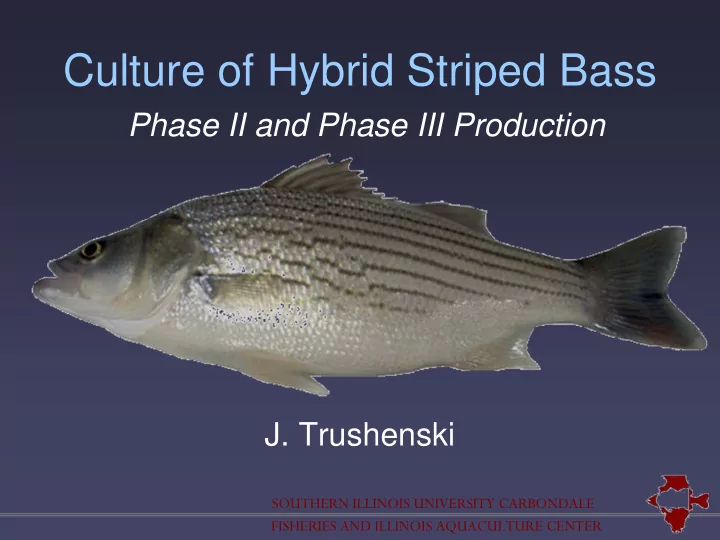

Culture of Hybrid Striped Bass Phase II and Phase III Production J. Trushenski SOUTHERN ILLINOIS UNIVERSITY CARBONDALE FISHERIES AND ILLINOIS AQUACULTURE CENTER
Phase II Production Production Cycle • From Phase-I harvest to 1 year old • Growing season: June to October • Can survive winters well • Grow from 1-2 to 10 inches (25-50 to 250 mm) Most rapid weight gain occurs during Phase II • Highest growth rates • Aggressive feeding Taking full advantage of rapid growth stage requires careful monitoring of water quality, nutrition, and feed management
Feeds To support rapid muscle gain and high activity level, typical feeds contain • 36-50% protein • 10-16% fat Formulations currently in use • Salmon/trout diets • Striped bass diets Floating pellets preferred • Observe fish status • Easy opportunity to generally assess survival, size, and condition • Reduce or increase amount of feed according to demand
Pond Culture Phase II are stocked at lower densities • 4,000 – 100,000 fish/acre • Emergency aeration is essential For uniform size and increased survival • 10,000 to 24,000 fish/acre • Above 24,000 fish/acre need constant aeration
Pond Culture • No need for additional fertilizer • Feed and fish waste provide nutrients to support phytoplankton • Plankton may shade out submerged vegetation • Fertilizer increases phytoplankton and negatively effect O 2 and pH
Harvest Seine harvest similar to Phase I • Typically harvest when temperatures • Typically harvest when temperatures are below 54° °F (12 F (12° °C) C) are below 54 • Expect 0.25- -0.5 lb fish (8 0.5 lb fish (8 – – 10 in) 10 in) • Expect 0.25 • 85% survival is common • 85% survival is common • Concludes 1 st year in production cycle Restock for Phase III • Size grade fish by hand • Size grade fish by hand • Stock similar sized fish • Stock similar sized fish together for phase III together for phase III growout growout
Phase III Production Fish are grown out to market size • Second year of production cycle • 1 ½ to 2 lbs (0.7 to 1 kg) • Overwinter following Phase II harvest • Growing season June - October Production intensity increases • Large production load • Careful monitoring of water quality, feed, and predators Several production strategies employed • Ponds • Cages • Vertical raceways • Indoor recirculation systems
Pond Culture Larger ponds, lower stocking rates • 1-10 acres (0.5 to 4 ha ), usually 5-6 acres (2-2.5 ha) • 3440 fish/acre (8600 fish/ha) Susceptible to predation • Birds, raccoons • Deterrent devices (noise makers, decoys, etc.) often used Transition to slightly lower nutrient density feeds • 36-38% protein, 10% lipid typical Feed by blower • Twice daily • 2-3% of the combined weight of the fish • Never above 280 kg/ha
Harvest Harvest before third growing season • Seines • Boom truck and loading net • 90% survival is common Live cars are often used to hold fish in ponds while slaughter or other preparation occurs bank-side
Recirculating Aquaculture System (RAS) Culture Most intensive form of aquaculture Increased control over production environment • Little influence of natural limitations • Predation • Weather • Access With increased control comes increased complexity • Culturists must provide and maintain complete suite of environmental criteria
Components of RAS Culture Tanks • Round tanks, raceways, etc. Aeration or Oxygenation • Diffusers, liquid O 2 injection, etc. Solid Waste Removal • Sedimentation basins, screen filters, bead filters Biological Filtration • Fluidized bed filters, trickle filters, rotating biological contactors, etc. Optional components • Foam fractionation, carbon dioxide stripping, ozone or UV disinfection
Rapid Production, High Yields Produce 0.33 to 0.5 lbs/gallon of water Stocked at 0.25 lb will take approximately 5-7 months to reach market size (1.25 to 2.0 lbs.)
General RAS Characteristics Advantanges Disadvantages Reduced water requirements High initial investment Year-round production Complex systems Use existing buildings Expensive equipment High yields per gallon Increased power usage and dependency Improved feed conversions Water quality management Greater security Inefficiencies in filtration
Other Considerations for RAS High density livestock production can resulted in increased occurrence and quicker spread of disease • Similar to traditional feedlots Greater capital needed for construction and maintenance Increased training necessary for staff
Cages and Vertical Raceways Utilize existing surface water bodies to culture fish Constructed of durable and non-toxic mesh material mounted on a frame • Simplifies feeding • Reduces predation • Allows circulation of water through cage • High stocking densities may require mechanical circulation and/or aeration • Floats and is anchored to a dock or weight • Easy access
HSB Cage Culture Can grow from one gram to 1.5 to 2 pounds in 18 months Stocking densities range from 2.5 to 5 fish per cubic foot • One 4’x4’x8’ cage per surface acre of water at a high stocking density with water circulation and aeration
HSB Vertical Raceway Culture Similar to cages, but air lifts are used to move water through raceway (up to 450 gallons/min) Advantages over traditional cages • Higher stocking densities • 10-15 fish/cubic foot • Yields as high as 5000 pounds/acre/year • Improved water quality • Reduced manpower • Less off flavor Need emergency backup generators
Marketing Some markets prefer live fish or fillets, but whole-on- ice marketing is typical Slaughtered using ice bath or electrocution • Rapid death and careful handling is important • Cuts, tears and bruising make fish unappealing Whole-on-ice Live • Very small = 0.75 to 1.0 lbs. • 1.25 to 1.75 lbs. • Small = 1.0 to 1.5 lbs. • >2 lbs. too large • Medium = 1.5 to 2.0 lbs. • Large = 2.0 to 2.5 lbs. • Jumbo = 2.5 lbs. and up
3-Phase vs. 2-Phase Production Cycle Advantages Disadvantages No size grading and re- Less control of stocking between phase population density II and phase III Survival is hard to Reduced stress from estimate Handling Reduced costs Increased cost of fingerlings Stock larger fingerlings (10 g) to reduce size variation
Recommend
More recommend